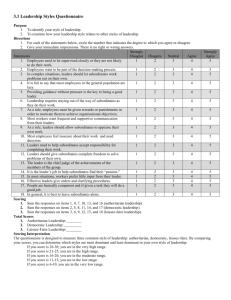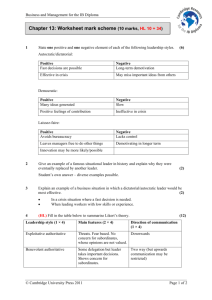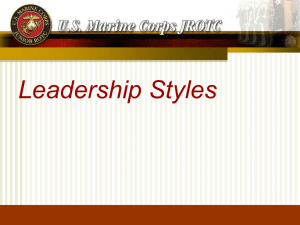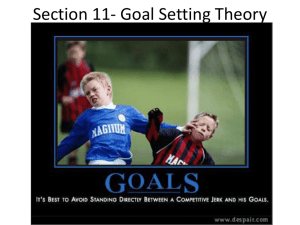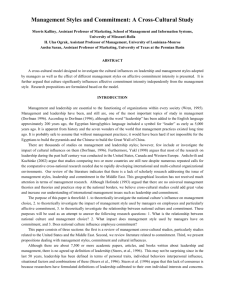Cpl 0205 SH - Military Training
advertisement
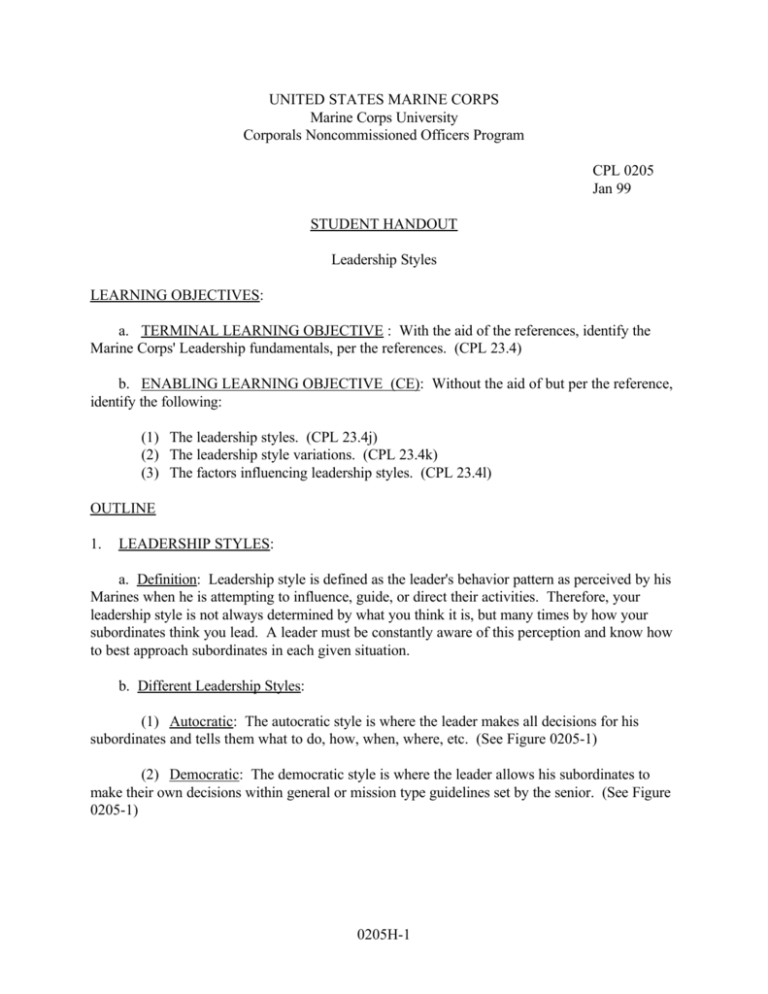
UNITED STATES MARINE CORPS Marine Corps University Corporals Noncommissioned Officers Program CPL 0205 Jan 99 STUDENT HANDOUT Leadership Styles LEARNING OBJECTIVES: a. TERMINAL LEARNING OBJECTIVE : With the aid of the references, identify the Marine Corps' Leadership fundamentals, per the references. (CPL 23.4) b. ENABLING LEARNING OBJECTIVE (CE): Without the aid of but per the reference, identify the following: (1) The leadership styles. (CPL 23.4j) (2) The leadership style variations. (CPL 23.4k) (3) The factors influencing leadership styles. (CPL 23.4l) OUTLINE 1. LEADERSHIP STYLES: a. Definition: Leadership style is defined as the leader's behavior pattern as perceived by his Marines when he is attempting to influence, guide, or direct their activities. Therefore, your leadership style is not always determined by what you think it is, but many times by how your subordinates think you lead. A leader must be constantly aware of this perception and know how to best approach subordinates in each given situation. b. Different Leadership Styles: (1) Autocratic: The autocratic style is where the leader makes all decisions for his subordinates and tells them what to do, how, when, where, etc. (See Figure 0205-1) (2) Democratic: The democratic style is where the leader allows his subordinates to make their own decisions within general or mission type guidelines set by the senior. (See Figure 0205-1) 0205H-1 Figure 0205-1 2. STYLE VARIATIONS: Between these two extremes are variations. These leadership style variations depend on how much authority and direction is either kept by the leader or is delegated to the subordinate. For the sake of discussion we can divide the continuum into four "basic" styles. As we discuss these four style variations remember that there are varying degrees of the basic styles based on the exact amount of authority the leader desires to use or delegate. A particular style of leadership might not be successful everywhere and might not be used effectively for everyone. What seems to be a "telling," or authoritarian style to one individual/group may be interpreted more like a "selling," or persuasive style to another. Sometimes we all need to be "told" what to do because our motivation, understanding, or experience level is low; at other times all we need is a mission to get us going. For example, your leadership must be consistent but your style should be flexible, what is effective in one situation may not get the same positive results in a similar situation at another time and place. a. Telling Style: This is characterized by one-way communication where the leader defines his followers' roles by "telling" them what to do, when to do it, how to do it, and where to do it. For example, it is very natural and intelligent to expect a leader to assume a very authoritarian "telling" style during a fire fight, or crisis situation; in fact our subordinates expect their leaders to 0205H-2 react on a forceful and decisive manner during these situations. It might be inappropriate for a leader to assume this "telling" style during a staff planning exercise when the objective is for the group to work out a complex plan ensuring that all points are covered. This style would be particularly incorrect if the staff was experienced and capable. To use a "telling" style in this case would show a lack of faith in their ability, demotivating them. I would not allow them to use their total "human resource" in developing the plan. b. Selling Style: The leader uses two-way communication to gain his followers' support by explaining the reasoning behind his decision. This style allows the subordinates minimal participation, but helps them to better understand and hopefully "buy into" the leader's decision. In this case the leader is explaining why he made the decision and then tries to "sell" the decision to the group by using persuasion. By taking them into his confidence relative to his decision, he will gain their support for his plan and they will be more motivated to go along with the plan. c. Participating Style: The leader allows the subordinates to be involved in the actual decision making process. It requires good two-way communication and the leader's willingness to be influenced by his subordinates' knowledge and opinions. Here the leader actually discusses possible alternative solutions with the group prior to making his decision. An example of this would be a battalion commander discussing his staff's "estimates" prior to selecting a course of action, or a company first sergeant discussing with the company SNCO's how they should prepare for a battalion inspection. d. Delegating Style: The leader provides mission-type orders/guidelines and minimal supervision. Essentially, the group is allowed to run its own show within the limits provided by the leader. The leader has provided his subordinates their limits, guidelines, and necessary authority to complete the task; he then gives them their mission, and allows them to accomplish the mission as they see fit. An example here is the company commander turning over the weekly field day to the company gunnery sergeant. The company gunnery sergeant knows what needs to be done, when it's to be done, the expectations of the commanding officer, and the resources available. Now he formulates his own plan of execution and accomplishes the task as directed. 3. FACTORS THAT INFLUENCE LEADERSHIP STYLES: Some of the factors that can affect a leader's style are: the individual or group being led, the mission, the situation, and of course the leader himself. Let's look at each of these factors in a little more detail. a. The Individual or Group Being Led: When evaluating the individual or group that you are going to lead there are some very critical areas that you must carefully consider. These areas are their abilities, experience, training, willingness, interest, motivation, unit size/composition/organization, and expectations. (1) Ability, Experience, and Training: The greater the ability of the individual or group to accomplish the task or mission, the less direct supervision and guidance is required from the leader. A platoon sergeant who knows that Squad Leader "A" knows how to properly prepare his squad for an inspection and is dependable, would not have to supervise that squad leader very 0205H-3 closely, but Squad Leader "B" who is less experienced, would probably require more supervision to achieve the same results. (2) Willingness, Interest, and Motivation: The greater the willingness to accomplish the task or mission, the less "forceful" the leader needs to be. An individual's or group's motivation level will determine how much "push" and supervision the leader needs to exert to get the job done. The less the motivation, the more "push" is necessary. (3) Size, Composition, and Organization: As the size of the group increases, the more diverse the group becomes relative to ability and interest, and the greater the need for organization. In line organizations, this is not much of a problem, because as the unit size increases, the chain of command structure is designed in most cases to maintain the three to one ratio. The problem does increase when the leader deals directly with larger numbers of personnel, such as in a classroom environment of a headquarters staff type unit. (4) Expectations: What type of leadership style does the group expect from its leaders? This can be important during transition periods between leaders. If the "old leader" was primarily a "participator" and your predominate tendency is to be a "teller," you must be aware that during the transition period there may be some confusion and difficulty in the communication process between yourself and your subordinates because of the difference in styles that they are used to. b. The Mission: The more complex the requirement, the greater the need for specific direction from the leader as to who does what, to whom, when, why, and how. If a task requires very specific coordination and attention to a specific plan, then the leader does not have much choice in style, he simply must "tell" his subordinates how, who, what, and when it will be done. c. The Situation: The shorter the time available to accomplish a task, the more directive a leader should be. In crisis situations leaders are expected to take charge and make decisions. There is little time for discussions during fire fights or emergency situations. During crisis situations subordinates look to their leaders for direction and expect concise orders, not questions. d. The Leader: The leader's personal values will affect his natural tendencies. The leader's degree of confidence will also be a key factor. The more confidence a leader has in the group or individual the less will be his tendency to direct how to accomplish a task. The self confidence level of a leader plays a critical part as well. The less confident a leader feels about himself the more likely he will be directive in nature. The less confident leader will usually go step-by-step until he feels he knows everything is going along properly. All of us have a natural leadership style that we feel more comfortable with. It is important to be ourselves and not attempt to assume a style that is not natural as it tends to confuse our subordinates. By recognizing our natural tendency, we can evaluate this predominate style more accurately, and when the situation requires a shift in leadership style, accomplish it more effectively. REFERENCE: Marine Corps Values and Leadership User’s Guide for Discussion Leaders 0205H-4
